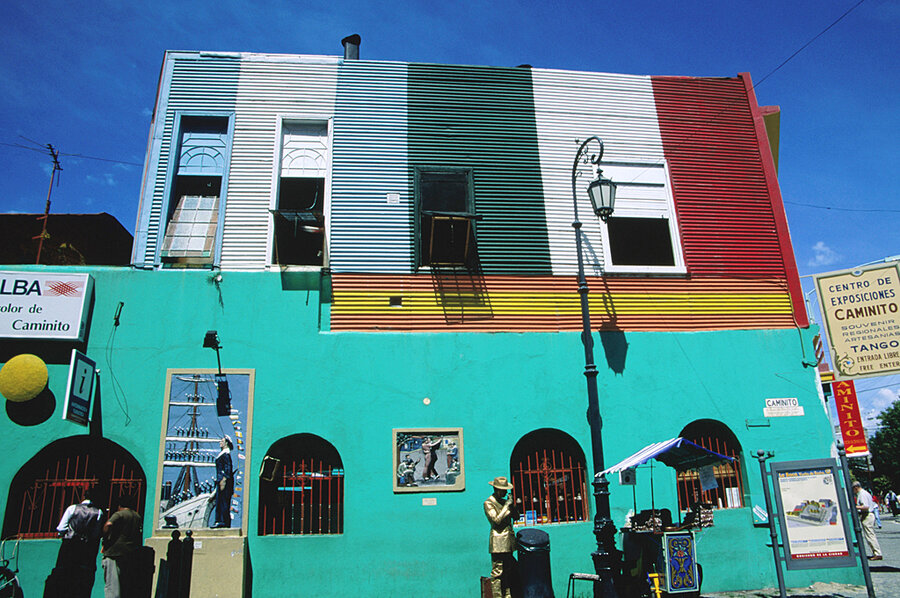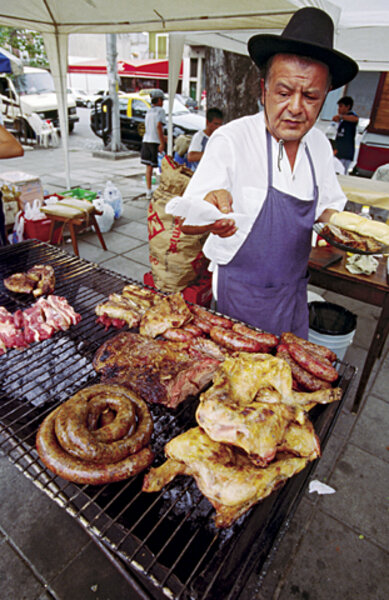Discover good food in Buenos Aires
Loading...
| Buenos Aires
Writer and poet Jorge Luis Borges praised his birth city in essays and poems. Since 2010 is the bicentennial of the city, it seems fitting to remember "The Mythical Founding of Buenos Aires." The last stanza is quoted often:
Hard to believe Buenos Aires had any beginning
I feel it to be as eternal as air and water.
It's hard to imagine Buenos Aires in the early years, when the area was covered by fields and crossed by creeks. Besides the enormous wealth generated from the fertile soil, the advent of railroads raised economic power. Prosperity drew wave after wave of immigrants from Europe. Buenos Aires soon became a city that rivaled major world capitals.
Today its 48 barrios are a collage of Old World architecture, heavily influenced by France and Spain. Every block is tightly packed – grandiose buildings share space with compact grocery stores. Cheese shops are as prolific as store windows displaying tango stilettos. You can't toss a French roll without hitting a bakery.
Despite their dress-to-the-nines-before-noon style, porteños (those who live here) are remarkably informal. Outgoing, too, and friendly to foreign visitors, especially those who try their hand at Spanish. A casual street-corner chat with a local might end up in a cafe, trading political views over espresso.
Most of the cafes are classic; all are crowded. Coffee and conversation are integral to the city's social life.
The two-tiered Café Impresso in the rear of El Ateneo Grand Bookstore (on Avenida de Santa Fe) is more than a trendy coffee spot; it's considered by many to be one of the world's grand cafes.
It was built as an opera house in 1919. Performances included appearances by legendary tango artists Carlos Gardel, Francisco Canaro, and Ignacio Corsini. In 1929, the building was converted into a book and music store.
Where else can you sip cortado (espresso "cut" with warm milk) in a theater box, surrounded by marble columns and gold-leaf sconces as you leisurely thumb through a collection of Borges's poems and Argentine cookbooks?
As you sink down into a plush chair and nibble on a rich dessert, don't forget to look up. An impressive mural by Italian artist Nazareno Orlandi sprawls across the high ceiling.
Another in-the-rear venue, Notorious (on Avenida Callao) is a jazz-infused supper club tucked behind a CD store. Patrons sit up close to a wide variety of local and touring musicians, showcasing the city's diverse taste in music.
The cover charge is reasonable, as is a menu featuring gourmet sandwiches, salads, pastas, and desserts. "Porgy and Bess" is a rich cheesecake drizzled with white chocolate.
Buenos Aires's restaurants reflect the diversity of the city's origins: Italian, Spanish, French, Basque, Greek, and Armenian. Peruvian-style cuisine is a new trend.
Still, some chefs are reevaluating the meals they remember being served in their grandmother's kitchens and combining local dishes using fresh herbs and vegetables with Mediterranean- or Asian-style elements.
Chefs take pride in their creations: "Fresh sole" on the menu means that the fish was dropped off that morning, and "home-made ravioli" was hand-cut and stuffed on the premises.
Many chefs like to chat tableside with patrons about new sauces or unusual ingredients.
Even those on a budget should consider preset lunches (menú del dia), a great way to indulge at an otherwise pricey restaurant. At La Parolaccia (on Calle Riobamba), for instance, a three-course lunch is about $10 and includes a variety of freshly baked breads.
Most restaurants post menus outside for viewing; some have websites. All invite diners to linger long after plates have been cleared. You "own" your table, even when there's a line waiting.
Buenos Aires is known for its sweet tooth. Heladerías (ice cream vendors) tempt passersby with flavors rarely found elsewhere, such as chunky caramel with figs and walnuts. It's an Italian, gelato-style ice cream, which contains more milk and less cream than its American cousin. And since there's less air, scoops are denser, each bite more intense.
Another high-calorie obsession is dulce de leche, sweetened milk boiled until it is the consistency of caramel. The thick paste is whipped into ice cream and pastries and spread on pancakes and toast.
Fortunately for visitors' waistlines, Buenos Aires is a walking city. Laid out on a grid, a logical numbering system makes navigation relatively simple. Avenidas are wide thoroughfares, while calles are generally narrower.
Porteños love to walk. Garages are at a premium and parking is nearly impossible. Both are good reasons for picking up groceries in small quantities at the neighborhood mercado, the kind Americans used to call mom and pop stores.
In a space the size of a school bus, you can find everything from laundry detergent and soda water to wheels of cheese and handmade empanadas. Fruit and vegetables are trucked in daily from nearby farms. Soil still clings to onions. There's an earthy smell to mercados – and not a shopping cart in sight.
On weekends, people pack picnics and head to plazas and parks along Avenida del Libertador. Elders sip hot yerba maté through metal straws stuck into hollowed-out gourds. Live bands play, jugglers perform, acrobats entertain young and old. Everyone has a good time.
Hundreds of vendors crowd nearby Plaza Francia for Recoleta Fair, the largest outdoor handicrafts fair in the city. All manner of arts and crafts fill the stalls: silver jewelry, wooden toys, leather goods. Children sell sandwiches. "Whole wheat bread!" they shout. "Vegetarian!"
In Buenos Aires, people dine late, dance late, and rise late to do it all over again. The best way to experience the city's personality is to sample a variety of foods every day.
You'll learn more than you expected by eating as the locals do.
---
Related stories:
Little Tokyo, Los Angeles: Getting the flavor of the place
Macarons conquer Paris, now London
Pungent pleasure: fish sauce secrets in Vietnam
Indian Food: Vada Pav, Mumbai's chutney-slathered vegetarian food






